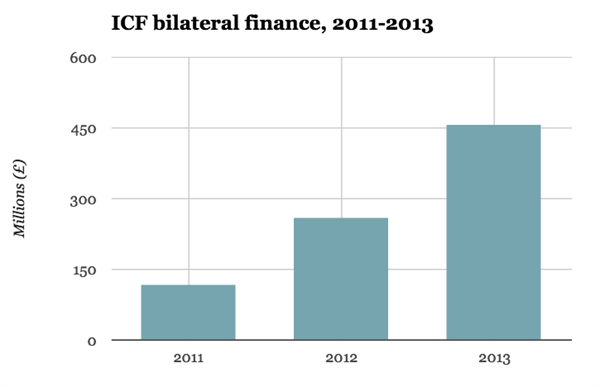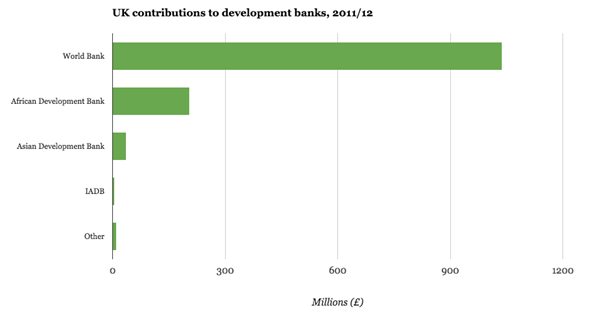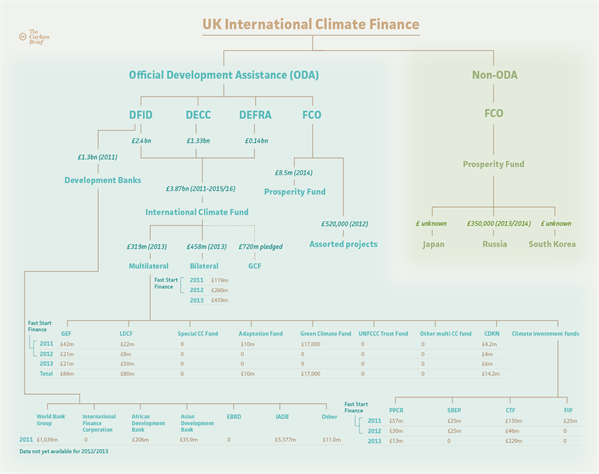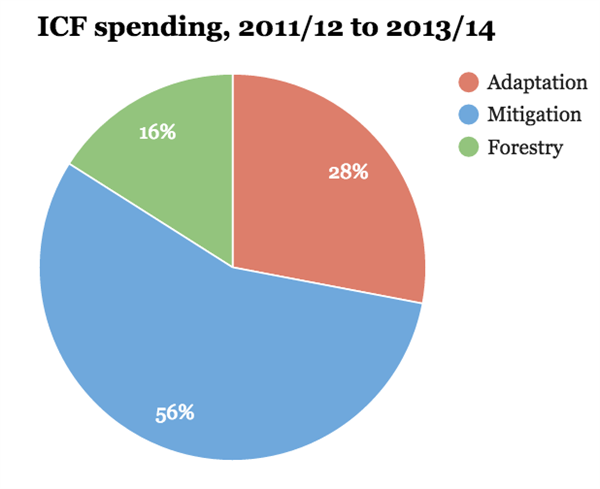Sophie Yeo
15.07.2015 | 9:55amIn the world of climate finance, 2020 is an important year. By this point, as was agreed at the Copenhagen climate conference in 2009, developed countries are expected to “jointly mobilise” $100bn per annum for developing nations.
The agreement didn’t identify exactly how this money should be raised. The final accord said: “This funding will come from a wide variety of sources, public and private, bilateral and multilateral, including alternative sources of finance.” As is the case with other developed countries, pressure is growing on the UK to play its part.
Between now and 2020, there are no formal requirements on the UK to donate. But without proof that rich countries will contribute and have a credible plan to scale up funds between now and the end of the decade, many commentators say it will be difficult to strike a meaningful deal at the UN’s climate conference in Paris this December.
The UK, which contributes 0.7% of its gross national income to overseas aid, is one of the most generous donors.
But how much of this goes towards climate finance, and how is it distributed? Carbon Brief looks at the available data.
Credit: Rosamund Pearce for Carbon Brief (click to enlarge)
International Climate Fund
The vast majority of the UK’s climate finance is channelled through its International Climate Fund (ICF).
This is a £3.87bn fund maintained by three government departments: the Department for International Development (DFID), the Department for Energy and Climate Change (DECC), and the Department for Environment, Food and Rural Affairs (DEFRA). The latter takes care of forestry issues relating to climate change.

Source: International Climate Fund (ICF) Implementation Plan. Chart by Carbon Brief
The ICF initially received £2.9bn of government funding when it was established by the previous government in the 2010 spending review. This pool of money was earmarked for 2011-2014, and was drawn from the 0.7% of gross national income dedicated to overseas development aid.
In the 2013 spending review, the government extended the ICF for a further year into 2015/16, and increased its funding to £3.87bn.
ICF money has a number of purposes, broadly aimed at reducing emissions, supporting adaptation projects and protecting forests in developing countries.
The UK’s £1.5bn in “ Fast Start Finance” was drawn from this fund. This is a pot of money, agreed at the Copenhagen climate conference in 2009, intended to start the flow of finance towards developing countries between 2010 and 2012.
That left a significant sum to be spent on other projects by the UK up to 2016.
By the end of the 2013/14 financial year, the ICF had spent £1.75bn, or 45% of its funding. The chart below shows how this was allocated.
Source: The UK’s International Climate Fund, Independent Commission for Aid Impact. Chart by Carbon Brief
The ICF says that its aim is to allocate 50% of its resources to adaptation, 30% towards mitigation, and 20% towards forestry, which suggests that current ICF spending is currently over-prioritising mitigation at the expense of adaptation.
Multilateral funds
The UK has to report to both the UN and the EU on how much climate finance is being sent abroad, and how it is being used.
The money from the ICF is split between multilateral and bilateral bodies. In the former instance, the UK has no control over which countries receive the money once it has deposited it; in the latter, the government can direct its funds towards certain countries and work with them on a one-to-one basis.
To date, 57% of the ICF has been spent multilaterally and 43% bilaterally. And by the end of the 2013/14 financial year, it had spent £1.75bn, or 45% of its funds.
The UK channels its multilateral funds through the following bodies:
-
Climate Investment Funds. There are four of these: Clean Technology Fund (CTF), Forest Investment Programme (FIP), Pilot Programme for Climate Resilience (PPCR), and Scaling Up Renewable Energy Programme (SREP)
The most recent data available on UK overseas climate spending is from the 2013/14 financial year.
This reveals that the UK provided £319m to these funds in 2013. The role of each body is to disburse funds from donor nations into projects designed to cut emissions or stave off the impacts of climate change in poorer nations.
The graph below shows how the UK allocated funds between the various bodies in 2013.

Source: UK reporting under Article 16 of MMR Regulations. Chart by Carbon Brief
This is just one year of a continuous cycle of donations coming out of the fixed £3.87bn pot.
The breakdown of previous years is available in the UK’s biennial submission to the UN’s climate body (from page 304), which sets out the history of UK climate spending since 2011, with granular detail on where the money went.
Between 2011 and 2013, for instance, the UK contributed funds to all four of the Climate Investment Funds referenced above. These were divided as follows:

UK donations to the Climate Investment Funds, 2011/12 to 2013/14. Source: UK reporting under Article 16 of MMR Regulations and The UK’s Sixth National Communication and First Biennial Report under the UNFCCC. Chart by Carbon Brief
In November 2014, the UK pledged £720m to the UN-backed Green Climate Fund. This will come from the ICF’s £3.87bn pot, and will make up a significant chunk when the UK reports its spending again later this year.
Bilateral funds
In 2013, the UK spent £459m funding bilateral programmes, where the government has control over which country receives the money.
These are the ten biggest projects of this kind that the UK supported in 2013.
Credit: Rosamund Pearce for Carbon Brief (click to enlarge)
Overall, the money put into projects funded in 2013 was divided as follows:

Source: UK reporting under Article 16 of MMR Regulations. Chart by Carbon Brief
Over the entire 2011 to 2013 period, the UK spent £838 million on bilateral projects within the International Climate Fund.

UK bilateral spending from the International Climate Fund between 2011 and 2013. Source: UK reporting under Article 16 of MMR Regulations and The UK’s Sixth National Communication and First Biennial Report under the UNFCCC. Chart by Carbon Brief
Foreign office spending
The UK has pledged to spend 0.7% of its gross national income on overseas development aid. According to the government’s 2013 spending review, this will amount to £12.2bn in spending over 2015/16, up from £11.7bn in 2014/15.
The majority of this is funnelled through the Department for International Development, which uses the portion earmarked for climate finance to fund the ICF, as explained above. DECC and DEFRA also fund the ICF, with their smaller ODA budgets.
But DFID, DECC and DEFRA are not the only departments with an interest in climate change which receive ODA funds. Most notably, the Foreign and Commonwealth Office was allocated an ODA budget of £418m in 2015/16.
Not all of this goes on climate change. The FCO received negative media attention recently after The Sun highlighted projects that received funding in 2014/15, including an Ethiopian television show to teach people about British values.
For 2015/16, the FCO has been allocated £418m in ODA funds. Around £28m of this goes towards subscriptions to international bodies. In addition, the British Council will receive £112.7 million.
However, the FCO does fund some climate change projects, primarily through the Prosperity Fund, which was set up by the department in 2011. The purpose of this fund is to support “openness, sustainability, opportunity and reputation” overseas in order to promote UK growth. In 2012, following a freedom of information request, The Guardian published details of FCO spending on climate change-related projects before this fund was established.
In 2015/16, this fund is due to receive around £25m, a portion of which will go to supporting low-carbon projects in industrialising countries.The Prosperity Fund is particularly designed to provide support in Brazil, China, India, Mexico, South Africa, South Korea and Turkey.
While the figures on how this is spent in 2015/16 are not yet available, a freedom of information request to the Foreign Office in 2014 indicated that the amount of money dedicated to climate change from the Prosperity Fund has diminished every year since it was established. In 2014/15, around £8.5m was spent on projects relating to climate and energy.

Source: Freedom of information release by FCO, 2014
An additional document published on the FCO website points to a list of additional Prosperity Fund projects in Russia in 2012-13. These did not come from the ODA budget. In 2013/14, they amounted to £350,000.
Projects included an effort to ensure that climate change was “properly addressed” during Russia’s G8 chairmanship in 2014. The UK has since ceased to provide contributions to Russia from its Prosperity Fund.
The UK has also given an unknown quantity of non-ODA money through the Prosperity Fund to South Korea and Japan. Carbon Brief has submitted a freedom of information request to the FCO seeking a full breakdown.
The Foreign Office also spends some of its ODA on climate projects in countries not targeted by the Prosperity Fund.
In 2012, spending records indicate that it spent $720,200 (around £460,000) supporting low-carbon projects and $97,460 (around £63,000) supporting adaptation in countries, including Argentina, Bolivia, Burma, Chile, Ecuador, Fiji, Malaysia, Philippines, Venezuela and others.
Similarly, in the third quarter of 2014/15, the FCO reported spending around £115,000 on low-carbon projects across a similar range of countries.
Development banks
Also included in the climate finance report that the UK presents biennially to the UN is the money it provides to development banks, including the World Bank, International Finance Corporation, African Development Bank, Asian Development Bank, European Bank for Reconstruction and Development and Inter-American Development Bank.
These funds are not specifically related to climate change, although these bodies will undertake work to promote low-carbon development and adaptation in developing countries. Climate finance continues to be relatively ill-defined term, which the banks are endeavouring to clarify. In 2014, controversy flared when it emerged that Japan had used its climate finance to fund a coal plant in Indonesia.
The funding for development banks comes from DFID’s wider ODA budget, rather than the International Climate Fund. The UK has not officially reported its most recent contributions to these. In 2011/12, it gave around £1.3bn, although it does not indicate how much of this went to climate change projects.

Source: The UK’s Sixth National Communication and First Biennial Report under the UNFCCC. Chart by Carbon Brief
Conclusion
This article has focused on the overseas climate finance that the UK reports to the UN. It is worth noting that the government has also spent money on schemes such as the Green Investment Bank, which supports the green economy on UK soil.
In future, it is likely that climate change spending will become more mainstreamed into the UK’s general development spending. This could make climate finance harder to track. However, it might also mean that overseas development projects can only proceed if they can demonstrate that they are resilient to climate change.
This autumn, the new government is expected to publish its comprehensive spending review. With pressure on the UK to both reduce public spending and scale up its climate finance contributions in the years ahead, the International Climate Fund and Prosperity Fund may soon come under much closer scrutiny.




